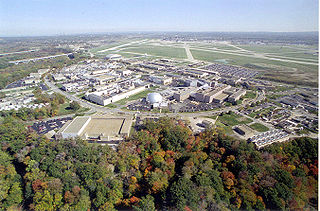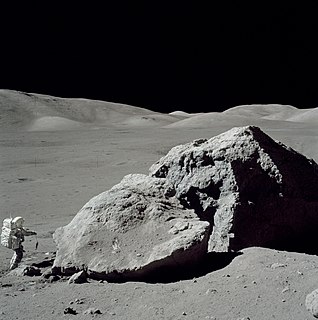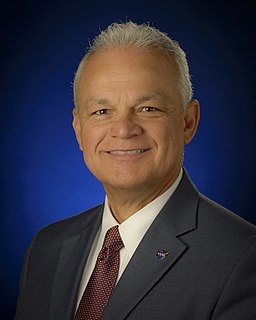
NASA John H. Glenn Research Center at Lewis Field is a NASA center within the cities of Brook Park and Cleveland between Cleveland Hopkins International Airport and the Rocky River Reservation of Cleveland Metroparks, with a subsidiary facility in Sandusky, Ohio. Its director is Marla E. Pérez-Davis. Glenn Research Center is one of ten major NASA facilities, whose primary mission is to develop science and technology for use in aeronautics and space. As of May 2012, it employed about 1,650 civil servants and 1,850 support contractors on or near its site.
As a federal agency, the National Aeronautics and Space Administration (NASA) receives its funding from the annual federal budget passed by the United States Congress. The following charts detail the amount of federal funding allotted to NASA each year over its history to pursue programs in aeronautics research, robotic spaceflight, technology development, and human space exploration programs.
JSON is an open standard file format and data interchange format that uses human-readable text to store and transmit data objects consisting of attribute–value pairs and arrays. It is a common data format with a diverse range of functionality in data interchange including communication of web applications with servers.
A web API is an application programming interface for either a web server or a web browser. It is a web development concept, usually limited to a web application's client-side, and thus usually does not include web server or browser implementation details such as SAPIs or APIs unless publicly accessible by a remote web application.

United Space Alliance (USA) was a spaceflight operations company. USA was a joint venture which was established in August 1995 as a Limited Liability Company (LLC), equally owned by Rockwell International and Lockheed Martin. The sale of Rockwell's aerospace and defense assets, including the Rockwell Space Operations Company (RSOC) and the Space Transportation System Operations Contract (STSOC) to Boeing in December 1996 made Boeing the co-owner along with Lockheed for the rest of the company's corporate existence. The company was headquartered in Houston, Texas and in 2008 employed approximately 8,800 people in Texas, Florida, Alabama, and the Washington, D.C. area. In 2014, the company was in the process of dissolving. The company was finally dissolved on 20 December 2019.

Daniel R. Mulville is an American engineer who served briefly as Acting Administrator of NASA in 2001.
The Scientific and Technical Information (STI) Program of the National Aeronautics and Space Administration (NASA) collects, organizes, preserves, and releases the Agency's scientific and technical information. STI is derived from NASA's research and development efforts and NASA projects, programs, and missions. The program is essential in helping NASA avoid duplication of research, by sharing information to ensure that the U.S. maintains its preeminence in aerospace-related industries and education. Examples of NASA STI include technical papers and reports, contractor reports, conference papers and proceedings, journal articles, presentations, and technical information on websites. NASA STI also includes research information from NASA's predecessor agency, the National Advisory Committee for Aeronautics (NACA), which dates back to 1915 and transitioned to NASA at the advent of the National Aeronautics and Space Act of 1958 (Amended).

The National Aeronautics and Space Administration is an independent agency of the U.S. federal government responsible for the civilian space program, as well as aeronautics and space research.

The National Space Council is a body within the Executive Office of the President of the United States created in 1989 during the George H. W. Bush administration, disbanded in 1993, and reestablished in June 2017 by the Donald Trump administration. It is a modified version of the earlier National Aeronautics and Space Council (1958–1973).
NASA's Solution for Enterprise-Wide Procurement (SEWP) is a United States Government-Wide Acquisition Contract (GWAC) authorized by the U.S. Office of Management and Budget (OMB) and managed by the National Aeronautics and Space Administration (NASA).

The space policy of the United States includes both the making of space policy through the legislative process, and the implementation of that policy in the United States' civilian and military space programs through regulatory agencies. The early history of United States space policy is linked to the US–Soviet Space Race of the 1960s, which gave way to the Space Shuttle program. There is a current debate on the post-Space Shuttle future of the civilian space program (NASA).

Orion is a class of partially reusable crewed spacecraft to be used in NASA's Artemis program. The spacecraft consists of a Crew Module (CM) space capsule designed by Lockheed Martin and the European Service Module (ESM) manufactured by Airbus Defence and Space. Capable of supporting a crew of six beyond low Earth orbit, Orion can last up to 21 days undocked and up to six months docked. It is equipped with solar panels, an automated docking system, and glass cockpit interfaces modeled after those used in the Boeing 787 Dreamliner. A single AJ10 engine provides the spacecraft's primary propulsion, while eight R-4D-11 engines, and six pods of custom reaction control system engines developed by Airbus, provide the spacecraft's secondary propulsion. Although compatible with other launch vehicles, Orion is primarily intended to launch atop a Space Launch System (SLS) rocket, with a tower launch escape system.
Machine-readable data, or computer-readable data, is data in a format that can be processed by a computer. Machine-readable data must be structured data.
The Consultative Committee for Space Data Systems (CCSDS) was founded in 1982 for governmental and quasi-governmental space agencies to discuss and develop standards for space data and information systems. Currently composed of "eleven member agencies, twenty-eight observer agencies, and over 140 industrial associates," the CCSDS works to support collaboration and interoperability between member agencies through the establishment of data and system standards. According to the organisation's website, more than 1000 space missions have utilized data and systems standards created by CCSDS. The activities of the CCSDS are organized around six topic areas and composed of many working groups within the overall Collaborative Working Group Environment (CWE).

The NASA Authorization Act of 2014 is a bill that would authorize the appropriation of $17.6 billion in fiscal year 2014 to the National Aeronautics and Space Administration (NASA). NASA would use the funding for human exploration of space, the Space Launch System, the Orion spacecraft, the Commercial Crew Program, the International Space Station (ISS), and various technological and educational projects.

NASA International Space Apps Challenge is annual NASA's global hackathon, first held in April 2012, and serves as innovation incubation and civic engagement program. NASA and its partners put out challenges relating to current work for which space enthusiasts around the world of all backgrounds can develop innovative solutions, particularly focusing on use of NASA data and promoting education. The project, formerly run by NASA's Office of the Chief Information Officer, is part of NASA's Earth Science Mission Directorate and is a part of the Open Government Initiative founded under President Barack Obama "creating an unprecedented level of openness in Government." It also fulfills the United States’ commitments to the Open Government Partnership.

Since its establishment in 1958, NASA has conducted research on a range of topics. Because of its unique structure, work happens at various field centers and different research areas are concentrated in those centers. Depending on the technology, hardware and expertise needed, research may be conducted across a range of centers.

The Exceptional Public Achievement Medal is an award of the National Aeronautics and Space Administration (NASA) established in 1959. It is awarded to any non-Government individual or to any individual who was not a Government employee during the period in which the service was performed. The award is for a significant specific achievement or substantial improvement in operations, efficiency, service, financial savings, science, or technology which contributes to the mission of NASA.
A machine-readable document is a document whose content can be readily processed by computers. Such documents are distinguished from machine-readable data by virtue of having sufficient structure to provide the necessary context to support the business processes for which they are created.

The Chief Technologist is the most senior technology position at the National Aeronautics and Space Administration (NASA). The Chief Technologist serves as the principal advisor to the NASA Administrator in technology policy and programs, and as interface to the national and international engineering community. The position helps "communicate how NASA technologies benefit space missions and the day-to-day lives of Americans."















